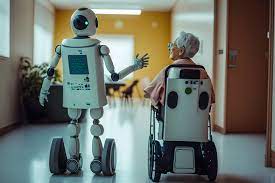The Intersection of Robotics and Healthcare
In recent years, the field of healthcare has witnessed a remarkable transformation driven by advancements in robotics technology. From robotic surgeries to AI-powered diagnostics, these innovations are revolutionizing the way medical professionals diagnose, treat, and care for patients. In this article, we explore the profound impact of robotic advancements on healthcare delivery and patient outcomes.
The Evolution of Robotics in Medicine
1. From Sci-Fi to Reality: A Brief History
- Robotics has long captured the imagination of scientists and storytellers alike, with depictions of futuristic machines performing complex medical procedures. Today, this vision has become a reality, with robotic systems playing an increasingly prominent role in various aspects of healthcare.
2. Pioneering Applications in Surgery
- One of the most significant contributions of robotics to healthcare is in the field of surgery. Robotic surgical systems, such as the da Vinci Surgical System, enable surgeons to perform minimally invasive procedures with unparalleled precision and control, resulting in shorter recovery times and reduced risk of complications for patients.
3. Enhancing Diagnostic Accuracy
- AI-driven robotic systems are revolutionizing diagnostic processes by analyzing vast amounts of medical data to identify patterns and trends that may be imperceptible to the human eye. This capability enables early detection of diseases and more accurate treatment planning, ultimately improving patient outcomes.
The Impact on Healthcare Delivery
1. Improving Access to Care
- Robotic advancements are bridging geographical barriers and expanding access to specialized medical care. Telemedicine platforms equipped with robotic interfaces allow patients in remote areas to consult with healthcare providers and receive expert guidance without the need for travel.
2. Personalizing Treatment Approaches
- By leveraging machine learning algorithms and predictive analytics, robotic systems can tailor treatment plans to individual patient needs, taking into account factors such as genetic predispositions, lifestyle habits, and environmental factors. This personalized approach maximizes treatment efficacy and minimizes adverse effects.
3. Empowering Healthcare Professionals
- Robotics technology augments the capabilities of healthcare professionals, enabling them to perform complex procedures with greater precision and efficiency. By offloading repetitive tasks to robotic systems, clinicians can focus their time and expertise on more strategic aspects of patient care, enhancing overall productivity and job satisfaction.
Challenges and Opportunities Ahead
1. Overcoming Technological Barriers
- While robotic advancements hold immense promise for the future of healthcare, several challenges must be addressed, including interoperability issues, data security concerns, and regulatory hurdles. Collaborative efforts between industry stakeholders, policymakers, and healthcare providers are essential to overcoming these barriers and realizing the full potential of robotics in medicine.
2. Ensuring Ethical and Equitable Use
- As robotic technologies become more integrated into healthcare workflows, it’s crucial to ensure that they are deployed ethically and equitably. Safeguarding patient privacy, minimizing algorithmic bias, and promoting transparency in decision-making are paramount to building trust and confidence in robotic systems among patients and healthcare professionals alike.
A Future Defined by Innovation
The convergence of robotics and healthcare heralds a new era of medical innovation, where the boundaries of what’s possible are continually expanding. By harnessing the power of robotics technology, we have the opportunity to revolutionize healthcare delivery, improve patient outcomes, and enhance the overall quality of life for millions of people around the world.




